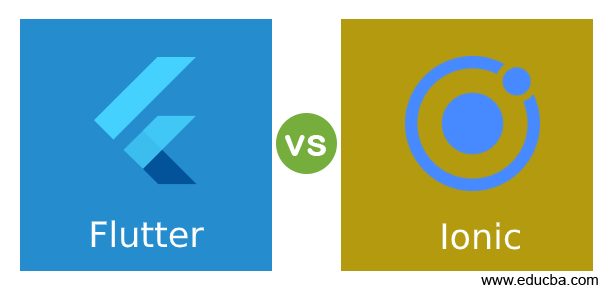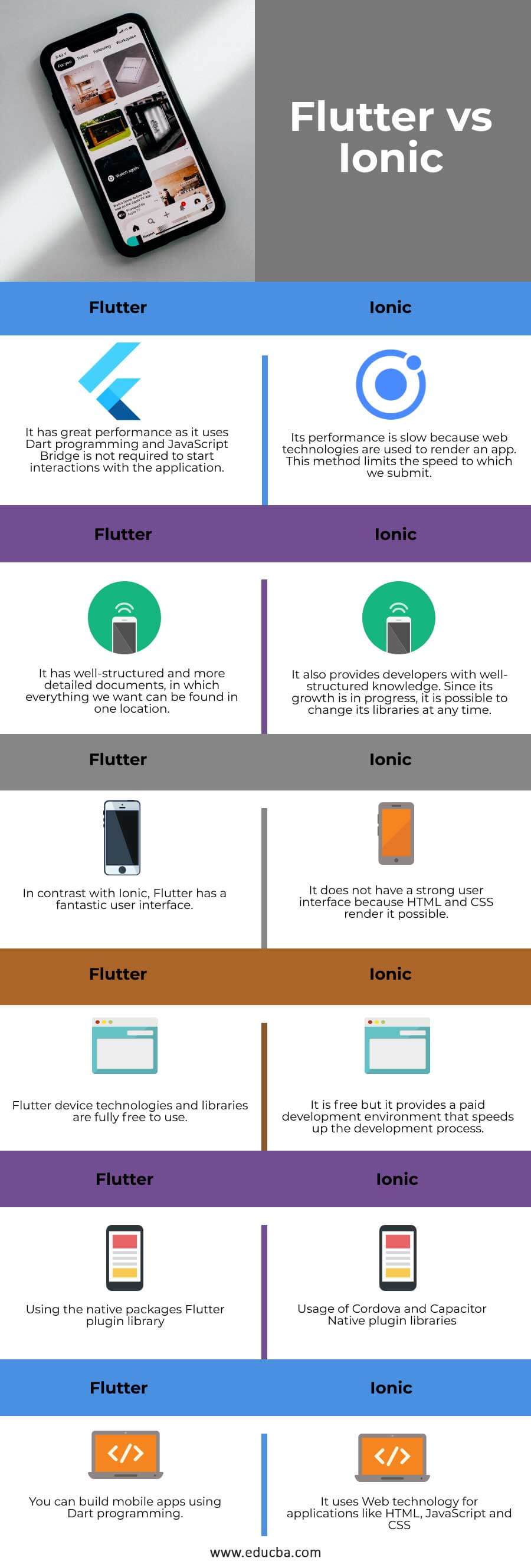Updated April 1, 2023

Difference between Flutter vs Ionic
The two leading technologies for developing mobile apps on both iOS and Android platforms are Flutter and ionic. It enables developers to easily prototype and publish compiled apps with a programming language and a single code base for smartphone, Internet, and desktop applications. The benefits of both systems depend on the particular criteria and goals of the company. In this section, the variations between Flutter and ionic frameworks will be contrasted according to the different parameters. We will address these developments briefly before making a comparison.
What is Ionic?
Ionic platform is an open-source UI toolkit for the development of high-quality web, desktop, and progressive Web apps using CSS, HTML, and JavaScript technologies. It has a feature to build and run all around once. In 2013, it was established by Max Lynch, Drifty Co., Ben Sperry, and Adam Bradley. In March 2014, the first beta version was released of the Ionic Platform. It focuses primarily on the front end-user experience or interaction between the users, which manages the look and feel of our app. It is easy to learn and can be integrated into other books or frameworks like Angular, Cordova, etc. It can also be used as an individual tool using a simple script without a front-end application.
What is Flutter?
Flutter is an interfacial interface toolkit that allows us to build fast, beautiful, and natively compiled mobile, web, and desktop applications with Dart languages. This builds the software with a single programming language and code base. It’s open-source and free. Google first developed it in May 2017 and now administers it according to an ECMA standard. It is an increasingly popular technology that provides excellent native experiences. Google launched SDKs to develop advanced iOS and Android mobile applications. If you are using Android Studio, the built-in Java and Objective C, and Swift is integrated on iOS.
Head to Head Comparison between Flutter vs Ionic (Infographics)
Below are the top 6 differences between Flutter vs Ionic:
Key Differences between Flutter vs Ionic
Following are the key differences between Flutter vs Ionic:
- Ionic provides a fairly simple web technology learning curve while flooding allows developers to learn Dart to build applications. With the support of the best Google developers and the community, Flutter is gradually growing. Ionic is also utilized by wrapper plugins for graphical apps or game development.
- Using the online platform and embracing open standards is the core philosophy of Ionic. When you develop with Ionic, you will accept the web tools and languages and the web architecture that provides mobile, desktop, and, in particular, the Internet, with high performance. Flutter has chosen to move forward in the more all-around world of growth, creating a self-contained ecosystem, which struggles with common languages, resources, and standards.
- Flutter and Ionic update the UI elements template in order to suit the application look, including Android materials and iOS Cupertino. They can also use a pre-built plugin library with a set of tools in order to build custom plugins, to access platform resources and native APIs.
- Ionic and Flutter share a shared dream to create beautiful, high-performance applications, which work everywhere. Yet the two are distinct internally. A fast comparison of Ionic and Flutter is given here. Partnering with Ionic Mobile App Development Company or Flutter company is critical.
Comparison Table of Flutter vs Ionic
Let us look at the comparison table of Flutter vs Ionic.
|
Flutter |
lonic |
| It has the great performance as it uses Dart programming and JavaScript Bridge is not required to start interactions with the application. | Its performance is slow because web technologies are used to render an app. This method limits the speed at which we submit. |
| It has well-structured and more detailed documents, in which everything we want can be found in one location. | It also provides developers with well-structured knowledge. Since its growth is in progress, it is possible to change its libraries at any time. |
| In contrast with Ionic, Flutter has a fantastic user interface. | It does not have a strong user interface because HTML and CSS render it possible. |
| Flutter device technologies and libraries are fully free to use. | It is free but it provides a paid development environment that speeds up the development process. |
| Using the native packages Flutter plugin library | Usage of Cordova and Capacitor Native plugin libraries |
| You can build mobile apps using Dart programming. | It uses Web technology for applications like HTML, JavaScript, and CSS |
Recommended Articles
This is a guide to Flutter vs Ionic. Here we also discuss the flutter vs ionic key differences with infographics and comparison table. You may also have a look at the following articles to learn more –

